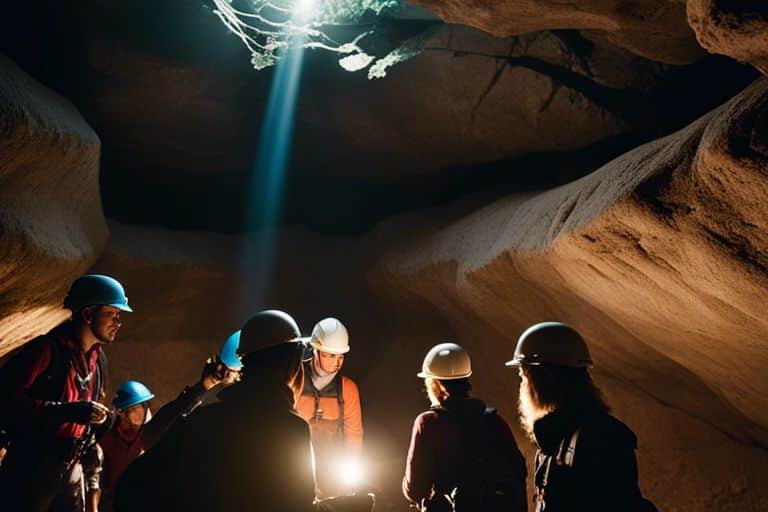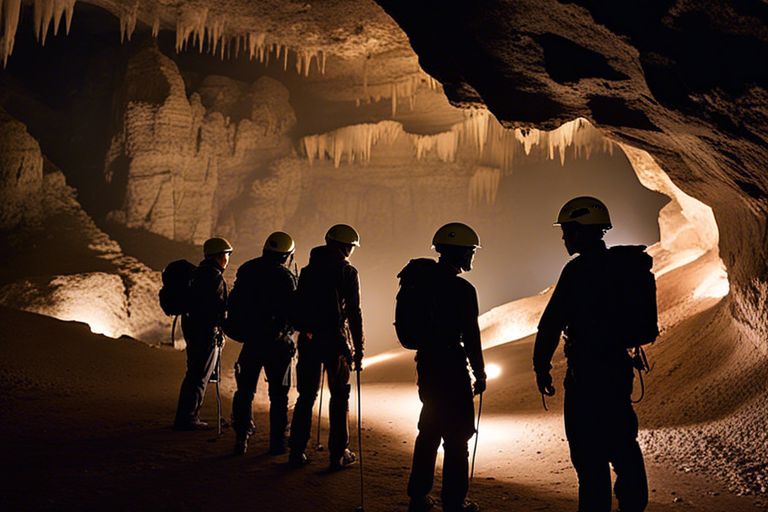Underground Wonders – Exploring Hidden Gems In Caves And Tunnels

There’s a mysterious world hidden beneath the surface of the Earth, where breathtaking formations, rare minerals, and hidden treasures await the adventurous souls willing to explore. Caves and tunnels, natural wonders that have been carved out over thousands of years, hold secrets and beauty that are waiting to be discovered. From shimmering crystals to ancient rock formations, these underground wonders offer a glimpse into a world largely unseen by many.
The Formation of Caves and Tunnels
Geological Processes Behind Cave Creation
On a geological timescale, caves are formed through a slow and steady process. Most caves are created through the dissolution of rock, primarily limestone, by acidic groundwater. Over thousands or even millions of years, water seeps through cracks in the rock, dissolving it and creating hollow spaces underground. As the process continues, larger voids are formed, eventually leading to the magnificent cave systems we see today.
Man-Made Tunnels: History and Engineering
Creation of tunnels by humans dates back centuries, with early civilizations developing rudimentary tunnels for mining and transportation purposes. The Romans were renowned for their advanced tunneling techniques, constructing elaborate systems of tunnels for water supply and transportation. In modern times, advancements in engineering have enabled the construction of complex underground tunnels for various purposes, such as subway systems, sewage networks, and underground passages.
Behind every successful man-made tunnel lies meticulous planning, innovative engineering solutions, and a deep understanding of geology and soil mechanics. Engineers must take into account factors such as soil stability, water table levels, and potential geological hazards while designing and constructing tunnels. Tunnel boring machines, reinforced linings, and ventilation systems are just a few of the technologies used to ensure the safety and functionality of these underground passageways.
Types of Caves and Tunnels
The world beneath our feet hides a multitude of wonders, from vast natural caves to intricate man-made tunnels. Understanding the different types of underground spaces can enhance our appreciation for the variety of formations that exist. Let’s examine into the diverse landscapes that make up the underground world.
Natural Caves: Limestone, Lava Tubes, and More
For centuries, natural caves have captivated explorers and scientists alike with their stunning formations and hidden mysteries. From the majestic limestone caves sculpted by water over millennia to the eerie lava tubes formed by volcanic activity, each type of cave offers a unique glimpse into the Earth’s geological history. Some caves, such as ice caves, are even formed by the interaction of ice and heat, creating ethereal landscapes of ice crystals and frozen waterfalls. Exploring these natural wonders can provide invaluable insights into the forces that shape our planet.
One of the most intriguing aspects of natural caves is their ability to preserve traces of ancient life forms and geological processes. The intricate formations found within these underground spaces, such as stalactites and stalagmites, offer vital clues to understanding past climates and environmental conditions. The intricate ecosystems that exist within caves, including unique species adapted to the darkness, further highlight the importance of these hidden environments in the broader ecological landscape. The study of natural caves continues to reveal new discoveries and enrich our understanding of the planet’s complex history.
Tunnels: From Ancient Passageways to Modern Subways
One of the most fascinating aspects of underground tunnels is their role in connecting different regions and civilizations throughout history. From the ancient passageways carved by early civilizations for transportation and defense to the modern subways that crisscross urban landscapes, tunnels have played a crucial role in shaping human societies. These underground conduits not only facilitate the movement of people and goods but also serve as repositories of architectural and engineering feats.
Ancient tunnels, such as the underground cities of Cappadocia in Turkey or the Cu Chi tunnels in Vietnam, provide a glimpse into the innovative ways in which past communities utilized underground spaces for protection and survival. In contrast, modern subways exemplify the advancements in tunneling technology and urban planning, offering efficient and sustainable transportation solutions for densely populated cities. The evolution of tunnels from ancient passageways to modern subways showcases the ingenuity and adaptability of human societies in harnessing the underground realm for various purposes.
Limestone formations are commonly found in natural caves due to the susceptibility of limestone to weathering and erosion processes. As water seeps through cracks in the limestone, it dissolves the rock and creates intricate cave systems filled with unique geological formations. The beauty of limestone caves lies in their delicate structures and the interplay of light and shadow that accentuates their otherworldly appearance.
The Ecosystems within Caves and Tunnels
Not all treasures lie above ground; some of the most fascinating ecosystems can be found hidden beneath the Earth’s surface in caves and tunnels. These subterranean habitats harbor a unique array of flora and fauna that have adapted to survive in the dark and isolated conditions found underground. Let’s examine into the mysterious world of the ecosystems within caves and tunnels to discover the hidden wonders that exist below our feet.
Unique Flora and Fauna in Subterranean Habitats
Subterranean ecosystems support a variety of specialized plants and animals that have evolved to thrive in the absence of light and limited resources. In these dark environments, you may encounter unique species such as troglobites, which are creatures adapted to living exclusively in caves. From eyeless fish to translucent insects, the diversity of life in subterranean habitats is truly remarkable and offers a glimpse into the resilience of nature.
Adaptations to Darkness and Isolation
Adaptations to darkness and isolation are crucial for survival in the depths of caves and tunnels. Many organisms have developed specialized features such as heightened senses of touch or smell, as well as unique metabolic processes to cope with the lack of sunlight and scarce food sources. Some species have even lost their pigment or eyesight entirely, relying on other senses to navigate their lightless surroundings. These fascinating adaptations highlight the incredible diversity of life forms that have successfully carved out a niche in these underground ecosystems.
The Cultural Significance of Underground Spaces
Caves and Tunnels in Mythology and Religion
Religion has often intertwined with the mystical allure of underground spaces, as seen in various mythologies and belief systems. Caves and tunnels hold a special place in the narratives of many cultures around the world. In Greek mythology, caves like the Cave of Hades symbolized the entrance to the underworld, representing a passage between the living and the afterlife. Similarly, in Hinduism, caves are considered sacred as they are believed to be abodes of gods and goddesses. The ancient Egyptians also held caves in high regard, using them for religious ceremonies and burial sites.
Historical Uses of Subterranean Chambers
The historical significance of subterranean chambers is profound, with these underground spaces serving multiple purposes throughout human history. From the catacombs of Rome used for burial purposes to the intricate tunnel systems of the ancient city of Petra used for transportation and habitation, underground spaces have played a crucial role in shaping civilizations. The utilization of caves and tunnels for storage, defense, and religious practices has left a lasting impact on various cultures worldwide.
The historical uses of subterranean chambers reflect the ingenuity and resourcefulness of ancient civilizations in maximizing the potential of underground spaces. Whether carved into rock formations or artificially constructed, these chambers showcase the innovative ways in which humans have adapted their environment to suit their needs.
Modern Explorations and Technologies
Advances in Cave Exploration Techniques
To uncover the secrets hidden beneath the Earth’s surface, modern cave exploration techniques have come a long way. With advancements in technology, explorers can now navigate through challenging terrains with greater ease and precision. From sophisticated mapping tools that create detailed 3D models of caves to specialized equipment for climbing and spelunking, the tools of the trade have evolved to make exploration safer and more efficient.
Cave divers now utilize state-of-the-art rebreather systems that extend their underwater exploration time and allow them to investigate deeper into submerged caves. Remote sensing techniques, such as LiDAR and ground-penetrating radar, have revolutionized the way we discover and study caves from the surface. These innovations have opened up new opportunities for researchers and adventurers to uncover the mysteries of underground landscapes.
Tunnel Technology: Innovations in Construction and Maintenance
Modern tunneling technology has transformed the way we build and maintain underground passages. With the development of tunnel boring machines (TBMs), construction projects can now efficiently carve their way through solid rock without the need for traditional drilling and blasting methods. These massive machines can bore tunnels of various shapes and sizes, reducing the time and manpower required for excavation.
A key innovation in tunnel construction is the use of precast concrete segments to form tunnel linings, providing structural support and waterproofing. Additionally, advancements in tunnel maintenance include smart monitoring systems that detect early signs of structural issues or water leaks, ensuring the safety and longevity of underground tunnels. With these cutting-edge technologies, the future of tunneling looks bright as we continue to push the boundaries of what lies beneath the surface.
Caves and Tunnels as Tourist Destinations
After millions of years of geological processes and human endeavors, caves and tunnels have transformed into mesmerizing destinations for adventurous travelers seeking to explore the mysteries of the underground world. These subterranean wonders offer a unique blend of natural beauty, history, and adventure, attracting tourists from around the globe.
Navigating the Risks and Rewards of Cave Tourism
With the allure of dark, expansive caverns and intricate limestone formations, cave tourism has seen a surge in popularity. However, the risks associated with exploring caves cannot be underestimated. Visitors must adhere to safety guidelines, which often include wearing helmets, proper footwear, and following experienced guides. Despite the potential hazards, the rewards of witnessing stunning stalactites and stalagmites in their natural splendor make cave tours a memorable and awe-inspiring experience.
The Infrastructure of Urban Tunnel Tours
An imperative aspect of urban tunnel tours is the infrastructure that supports these unique excursions. As visitors investigate into the underground passages of cities like Paris, New York, or Tokyo, they can appreciate the meticulous planning and safety measures in place. Well-lit pathways, emergency exits, and informative guides ensure that tourists can explore these hidden urban landscapes with ease and security.
Preservation and Future Challenges
Conservation Challenges for Caves and Tunnels
To ensure the longevity of these underground wonders, conservation efforts are crucial. Challenges such as environmental impacts, vandalism, and natural wear and tear pose significant threats to the preservation of caves and tunnels. It is imperative to implement strict regulations and monitoring systems to safeguard these delicate ecosystems and historical sites from irreversible damage. Collaboration between governing bodies, conservation organizations, and the public is crucial to address these conservation challenges effectively.
Balancing Access with Preservation Efforts
To strike a balance between allowing public access to caves and tunnels while preserving their integrity, careful planning and management are required. Limiting visitor numbers, providing guided tours, and implementing protective measures like boardwalks and proper lighting can help minimize the impact of human presence on these fragile environments. Preservation efforts should prioritize the conservation of unique geological formations, historical artifacts, and endemic species within caves and tunnels.
Access to these underground wonders must be carefully regulated to prevent overcrowding, minimize contamination, and maintain the authenticity of these natural and cultural treasures. By fostering a deeper appreciation for the significance of caves and tunnels through educational programs and sustainable tourism practices, we can ensure that future generations will have the opportunity to explore and admire these hidden gems.
Conclusion
Drawing together the enchanting beauty and mysterious allure of caves and tunnels, the world below the surface offers a unique and breathtaking experience for adventurers and nature enthusiasts alike. Exploring these hidden gems not only showcases the wonders of nature’s handiwork but also provides a deeper understanding of the geological processes that have shaped our planet over millions of years.
From the stunning stalactites and stalagmites of limestone caves to the intricate formations in underground rivers and lava tubes, the underground world is a treasure trove of awe-inspiring sights waiting to be discovered. Whether you are spelunking through winding passages or admiring the ancient artwork etched into cave walls, the underground wonders hold a special magic that continues to captivate and inspire all who dare to venture into this subterranean realm.

